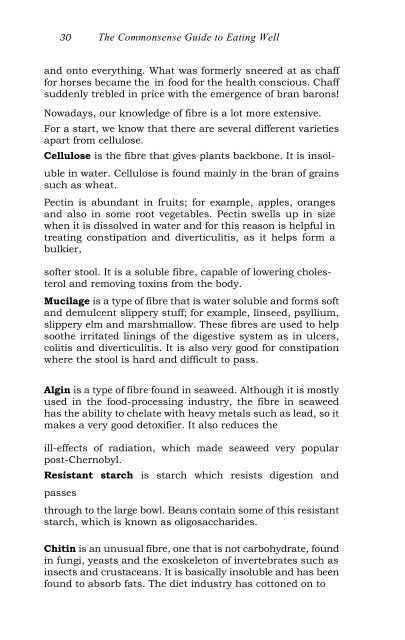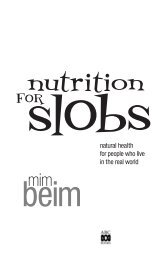Eating Well - Beaming with Health
Eating Well - Beaming with Health
Eating Well - Beaming with Health
You also want an ePaper? Increase the reach of your titles
YUMPU automatically turns print PDFs into web optimized ePapers that Google loves.
30 The Commonsense Guide to <strong>Eating</strong> <strong>Well</strong><br />
and onto everything. What was formerly sneered at as chaff<br />
for horses became the `in ' food for the health conscious. Chaff<br />
suddenly trebled in price <strong>with</strong> the emergence of bran barons!<br />
Nowadays, our knowledge of fibre is a lot more extensive.<br />
For a start, we know that there are several different varieties<br />
apart from cellulose.<br />
Cellulose is the fibre that gives plants backbone. It is insol-<br />
uble in water. Cellulose is found mainly in the bran of grains<br />
such as wheat.<br />
Pectin is abundant in fruits; for example, apples, oranges<br />
and also in some root vegetables. Pectin swells up in size<br />
when it is dissolved in water and for this reason is helpful in<br />
treating constipation and diverticulitis, as it helps form a<br />
bulkier,<br />
softer stool. It is a soluble fibre, capable of lowering cholesterol<br />
and removing toxins from the body.<br />
Mucilage is a type of fibre that is water soluble and forms soft<br />
and demulcent slippery stuff; for example, linseed, psyllium,<br />
slippery elm and marshmallow. These fibres are used to help<br />
soothe irritated linings of the digestive system as in ulcers,<br />
colitis and diverticulitis. It is also very good for constipation<br />
where the stool is hard and difficult to pass.<br />
Algin is a type of fibre found in seaweed. Although it is mostly<br />
used in the food-processing industry, the fibre in seaweed<br />
has the ability to chelate <strong>with</strong> heavy metals such as lead, so it<br />
makes a very good detoxifier. It also reduces the<br />
ill-effects of radiation, which made seaweed very popular<br />
post-Chernobyl.<br />
Resistant starch is starch which resists digestion and<br />
passes<br />
through to the large bowl. Beans contain some of this resistant<br />
starch, which is known as oligosaccharides.<br />
Chitin is an unusual fibre, one that is not carbohydrate, found<br />
in fungi, yeasts and the exoskeleton of invertebrates such as<br />
insects and crustaceans. It is basically insoluble and has been<br />
found to absorb fats. The diet industry has cottoned on to



